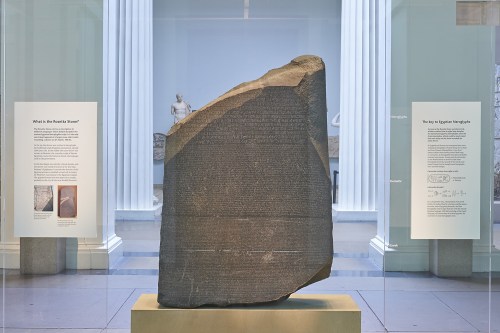
The Rosetta Stone is one the most important artifacts from ancient civilization but it wasn’t very important when it was first inscribed in 196 BC — one of many copies of a decree stating that a priest of a given temple supported King Ptolemy V for the sake of tax exemption. When these pagan temples were closed in the fifth century, knowledge of Egyptian hieroglyphics was lost, until the stone was discovered in 1799 and the scripts were deciphered two decades later.
Though discovered by Napoleon’s army, the Rosetta Stone eventually became property of the British after British troops defeated the French in Egypt in 1801. Still it was French scholar Jean-François Champollion who figured out that hieroglyphs recorded the sounds of the Egyptian language and thus opened the door for studying the language and culture more thoroughly. On September 27, 1822, over 20 years after the initial discovery of the Rosetta Stone, Champollion announced his discovery in a paper in Paris.
The Rosetta Stone arrived in England in February 1802 and was offered to the British Museum in July. At the time, the floors in the museum weren’t strong enough to support the weight of the slab, until additional funds helped build a new gallery strictly for artifacts acquired from the campaign.
“This scan was part of our larger attempt to capture as many of our iconic pieces from the collection — and indeed the unseen in store objects — and make them available for people to view in 3D or in more tactile forms,” Daniel Pett, a British Museum adviser who helped make the scan, told Digital Trends.
The stone isn’t the only object that the British Museum has scanned for the public. The Jericho skull (a plastered human skull that dates to between 7,000 and 6,000 BC), the Jennings Dog (a large Roman sculpture), and a series of Japanese netsuke figurines have also been scanned and uploaded online.
“We have around eight million objects, not all will be suitable for 3D scanning, but we have managed to capture over 200 so far,” Pett added. To view all of the British Museum’s scan, head over to their Sketchfab page and have a look around.